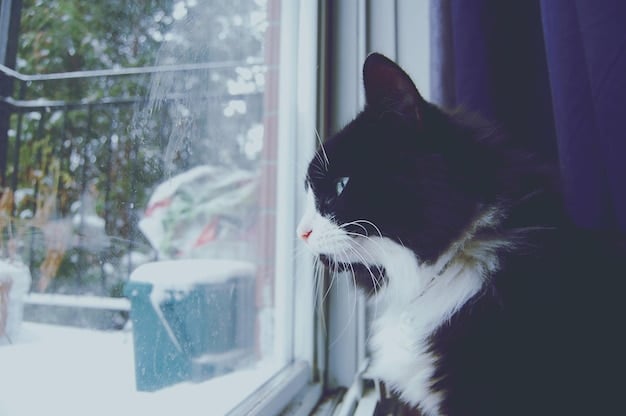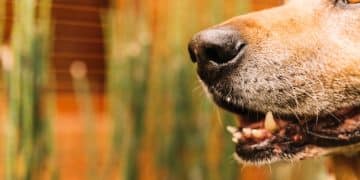Seasonal Affective Disorder in Pets: Understanding Animal Manifestations

Seasonal Affective Disorder in domesticated animals manifests through subtle behavioral, physiological, and emotional changes, often linked to reduced daylight exposure, impacting their well-being and requiring attentive observation from owners to mitigate symptoms.
As the days grow shorter and sunlight fades, many human experience a dip in mood known as Seasonal Affective Disorder (SAD). But what about our furry companions? The question of How Does Seasonal Affective Disorder Manifest in Domesticated Animals? is increasingly relevant, prompting a closer look at the subtle signs our pets might be exhibiting. This article delves into the intriguing possibility that our pets, much like us, can be affected by the changing seasons.
Understanding the Basics of SAD in Animals
The concept of Seasonal Affective Disorder (SAD) in domesticated animals might seem surprising to some, yet it aligns with our growing understanding of animal cognition and emotional states. Just as humans are influenced by the shifting patterns of light and darkness, many animals, particularly those that have evolved alongside us, demonstrate similar sensitivities to seasonal changes. This section lays the groundwork for understanding this fascinating phenomenon, exploring the fundamental mechanisms that might contribute to SAD-like symptoms in our pets.
The Role of Light and Melatonin
The primary driver behind SAD in humans is believed to be the reduction in natural light exposure during autumn and winter. This lack of light can disrupt the body’s internal clock (circadian rhythm) and alter the production of key neurochemicals. In animals, the pineal gland, responsible for producing melatonin, reacts similarly to light changes. Melatonin plays a crucial role in regulating sleep-wake cycles and mood. When daylight hours shorten, melatonin production can extend, leading to lethargy and depressive symptoms.
- Disrupted Circadian Rhythms: Shorter days can throw off an animal’s natural sleep-wake cycle, leading to confusion and fatigue.
- Increased Melatonin: Prolonged periods of darkness stimulate more melatonin, inducing drowsiness and a general lack of energy.
- Serotonin Imbalance: Reduced light often correlates with lower serotonin levels, a neurotransmitter vital for mood regulation, potentially leading to anxiety or sadness.
Species-Specific Sensitivities
While the general principles apply, the manifestation and intensity of SAD-like symptoms can vary significantly among different species of domesticated animals. For instance, cats, with their often solitary nature, might show more subtle changes, whereas dogs, being highly social, might exhibit more overt behavioral shifts. Understanding these species-specific nuances is key to accurately identifying potential seasonal mood changes. Certain breeds, too, might possess genetic predispositions that make them more or less susceptible to these environmental shifts. Factors such as coat thickness, natural habitat of their ancestors, and even their typical activity levels, all play a role in how they perceive and react to seasonal transitions.

Behavioral Manifestations of Seasonal Affective Disorder
Recognizing SAD in pets often boils down to keen observation of behavioral changes. These shifts can be subtle, mimicking other ailments, which makes careful monitoring essential. Pet owners must learn to differentiate between typical seasonal lethargy and more concerning signs of a mood disorder. A thorough understanding of what constitutes normal behavior for your pet, as well as an awareness of their typical routines, is paramount in identifying any deviations that might point towards SAD.
Changes in Activity Levels and Energy
One of the most common signs of SAD in pets is a noticeable decrease in their usual activity levels. Dogs may become less enthusiastic about walks or playtime, preferring to sleep more or remain sedentary. Cats might spend more time napping in dark corners. This isn’t just about sleeping more; it’s about a general reduction in zest for life. They might seem more sluggish, move slower, and be less responsive to familiar stimuli. This can often be mistaken for simple aging or boredom, making it crucial for owners to consider the seasonal context.
* Reduced Playfulness: Less interest in toys, games, or interactions with family members.
* Increased Lethargy: Spending more hours sleeping, often in secluded or dark areas.
* Lack of Enthusiasm: Showing diminished excitement for activities they once loved, like meal times or walks.
Appetite and Weight Changes
Another area where SAD can manifest is in an animal’s eating habits. Some pets might experience an increased appetite, leading to weight gain, similar to how some humans crave carbohydrates during winter. This might be a natural instinct to store fat for colder months, but an excessive increase can be a sign of emotional eating. Conversely, other pets might show a decrease in appetite, possibly due to a general malaise or a disruption in their digestive processes caused by stress. It’s important to monitor not only how much they eat but also their enthusiasm for food. Any significant or prolonged shift in weight or eating patterns warrants investigation.
Social Interaction and Irritability
Pets affected by SAD might also display noticeable changes in their social behavior. Normally affectionate dogs might become withdrawn, avoiding cuddles or interaction. They might even display increased irritability or aggression if approached, seemingly preferring solitude. Cats, already known for their independent streak, might become even more reclusive, hiding more often or becoming less tolerant of petting. These changes are particularly striking if the pet was previously very social. They might also react more negatively to new people or animals, indicating a heightened state of anxiety or discomfort. Observing these shifts requires a deep understanding of your pet’s personality and typical social cues.
Physiological and Emotional Indicators
Beyond overt behavioral shifts, SAD in domesticated animals can also carry physiological and emotional underpinnings that are often interconnected. These internal changes can be harder to spot but are equally important for a holistic understanding of their well-being. Recognizing these subtle cues can provide deeper insights into their seasonal struggles.
Anxiety and Stress Symptoms
Animals suffering from SAD might exhibit heightened levels of anxiety and stress. This can manifest in varied ways, from increased vocalizations like whining or meowing, to destructive behaviors, or even house-soiling in previously potty-trained animals. For dogs, excessive licking or chewing can be a self-soothing mechanism signaling stress. Cats might over-groom, leading to bald patches, or become more prone to spraying. These anxiety behaviors are often a result of discomfort with the reduced light and altered routines. They might also appear more restless, unable to settle down, or display signs of fear in familiar environments. The consistency and context of these behaviors are key to linking them to seasonal changes.
Coat and Skin Changes
The shift in seasons, particularly the decreased light, can also impact an animal’s physical appearance, specifically their coat and skin health. Some pets might experience a dulling of their coat, excessive shedding, or even skin conditions that seem to worsen during the darker months. While some shedding is normal as animals adjust their coats for winter, an unusual amount or quality can be a sign of dietary changes, stress, or a general decline in health linked to seasonal depression. Melatonin, beyond its role in sleep, also influences hair growth cycles and skin health, so its dysregulation could contribute to these issues. Owners might notice their pet’s coat losing its luster or becoming brittle.
Subtle Emotional Signals
Perhaps the most challenging aspect of identifying SAD in pets is discerning their emotional state. Animals cannot articulate their feelings, but they communicate through body language and subtle cues. A pet silently resting their head more often, avoiding eye contact, or a general lack of “spark” in their demeanor could indicate sadness. Dogs might carry their tails lower, have less animated facial expressions, or seem withdrawn. Cats might purr less or reduce their playful interactions. These nuanced emotional signals require a deep bond and attentive observation from the owner. It’s about noticing a departure from their usual happy-go-lucky or content disposition.
Contributing Factors and Risk Animals
Understanding How Does Seasonal Affective Disorder Manifest in Domesticated Animals? also requires an exploration of the factors that make some pets more susceptible than others. Not all animals will experience SAD, and various elements can heighten or mitigate their risk. This section explores these contributing factors and identifies which animals might be more vulnerable to seasonal mood changes.
Breed and Genetic Predisposition
Just like in humans, where certain genetic factors can make individuals more prone to SAD, there’s a growing belief that some animal breeds might have a genetic predisposition. For instance, northern breeds of dogs, such as Huskies or Malamutes, are instinctively adapted to shorter, darker days and may be less affected. Conversely, breeds originating from sunnier climates or those bred for high energy levels might be more sensitive to reduced light. These animals may have evolved with different internal clocks or neurotransmitter balances that are more easily disrupted by significant seasonal shifts. Their genetic makeup might influence how efficiently their bodies process light, produce serotonin, or regulate melatonin.
Age and Health Status
An animal’s age and overall health status play a significant role in their susceptibility to SAD. Older pets, whose internal systems might be less resilient, could be more vulnerable to the effects of seasonal changes. Their bodies might not adapt as quickly to shifts in light and routine. Similarly, pets with pre-existing health conditions, chronic pain, or compromised immune systems might find their symptoms exacerbated by seasonal mood changes. The added stress of SAD can further deplete their resources, making recovery more challenging. Young animals, too, can be affected, as their developing systems are still learning to regulate. A pet’s general well-being directly influences their ability to cope with environmental stressors.
Environmental Factors and Routine
The immediate environment and daily routine of a domesticated animal are powerful influences on their mood and behavior. Pets that spend a lot of time indoors, particularly in dimly lit environments, are more likely to experience the effects of reduced natural light. A lack of outdoor exercise and mental stimulation can further compound these feelings of lethargy and sadness. Changes in the owner’s routine during the colder months, such as less frequent walks or playtime, also contribute significantly. Animals thrive on routine, and disruptions, even subtle ones, can trigger stress or anxiety. The quality and quantity of light exposure within the home, as well as the consistency of their activities, are crucial for their mental health.
- Indoor Confinement: Limited access to natural light, especially during peak daylight hours.
- Reduced Exercise: Less outdoor activity leading to pent-up energy and boredom.
- Owner’s Routine Changes: Altered schedules affecting walks, feeding times, and interaction.
Management and Mitigation Strategies
Once you’ve identified potential signs of SAD in your pet, the next step is to implement strategies to help them cope. The goal is to counteract the effects of reduced daylight and maintain their overall well-being. These strategies focus on environmental adjustments, behavioral interventions, and, when necessary, professional advice. Effective management is key to ensuring that Seasonal Affective Disorder in Domesticated Animals doesn’t significantly impair their quality of life.
Light Therapy and Environmental Adjustments
One of the most effective strategies for SAD, in both humans and animals, is light therapy. This involves exposing your pet to specialized SAD lamps or full-spectrum lighting for a set period each day. These lights mimic natural sunlight, helping to regulate melatonin production and improve mood. Placing your pet’s bed or favorite resting spot near a window can also increase their exposure to natural light during the day. Maximizing natural light exposure within the home is a straightforward, budget-friendly approach. Ensure curtains are open, and consider trimming overgrown foliage that might block sunlight. Consistent exposure to bright light, especially in the morning, can help reset their circadian rhythms.
* SAD Lamps: Use specialized light therapy lamps for pets, following manufacturer guidelines for distance and duration.
* Natural Light Exposure: Position pet beds near windows; ensure ample natural light indoors.
* Open curtains and blinds during the day.
* Consider adding skylights or sun tubes if renovation is an option.
* Outdoor Time: Maximize outdoor time during daylight hours, even on cloudy days.
Enrichment and Activity Levels
Maintaining a consistent routine of physical and mental stimulation is crucial. Even if your pet is less enthusiastic, encouraging playtime, walks, and training exercises can make a significant difference. For dogs, varying walking routes or introducing new toys can spark interest. For cats, interactive laser pointers, puzzle feeders, or regular play sessions can combat lethargy. Mental enrichment, like puzzle toys or scent work, can also help keep their minds active and engaged, reducing feelings of boredom or despondency. The key is to make these activities appealing and consistent, even if it requires extra effort on the owner’s part. Preventing long periods of inactivity is fundamental.
Dietary Adjustments and Supplements
A balanced diet is always important, but during periods of potential SAD, adjustments might be beneficial. Some holistic veterinarians recommend diets rich in omega-3 fatty acids, which are known for their mood-boosting properties. Supplements containing tryptophan, a precursor to serotonin, might also be considered, though always under veterinary guidance. Ensuring your pet receives all essential vitamins and minerals can support their overall health and resilience. Avoid making drastic dietary changes without consulting a veterinarian, as sudden shifts can cause digestive upset. Focus on high-quality food and consider supplements that support brain health and mood stability.
The Link Between Pet and Owner Well-being
The well-being of a domesticated animal is often intricately linked to that of its owner. This connection becomes particularly salient when discussing conditions like Seasonal Affective Disorder. The manifestation of SAD in pets can, in turn, affect the owner’s mood, creating a cyclical relationship that highlights the importance of mutual care. Understanding this dynamic is crucial for effective management and support for both parties. Owners might notice their own mood changes reflected in their pet’s behavior, and vice versa.
Mirroring Emotions
Pets are remarkably perceptive creatures, often mirroring the emotional states of their human companions. If an owner is experiencing SAD, their symptoms—such as lethargy, reduced social interaction, or irritability—might inadvertently influence their pet’s behavior. Animals can pick up on subtle changes in body language, tone of voice, and routine. This mirroring effect can make it challenging to ascertain whether the pet’s SAD-like symptoms are primary or a response to the owner’s state. It underscores the importance of owners taking care of their own mental health as a direct means of supporting their pets. A depressed owner might less likely engage in activities that benefit their pet, further impacting the animal’s mood.
Impact on the Human-Animal Bond
When a pet is displaying signs of SAD, it can understandably cause distress and concern for the owner. Seeing a beloved companion withdrawn or unhappy can strain the human-animal bond, leading to feelings of guilt, frustration, or sadness on the owner’s part. This emotional impact can make it harder for owners to provide the consistent support and intervention their pet needs. Maintaining open communication with a veterinarian and seeking support for oneself can help alleviate these challenges. A strong, positive bond is a protective factor for both owner and pet, making it essential to nurture it through all seasons. Activities that strengthen this bond, such as interactive play or consistent affection, can be particularly beneficial during darker months.
Shared Strategies for Seasonal Wellness
Given the interconnectedness of human and animal well-being, many strategies for combating SAD can be shared. Activities like increasing outdoor exercise during daylight hours, ensuring a bright and stimulating home environment, and maintaining a healthy diet benefit both owner and pet. Engaging in these activities together can strengthen their bond and provide mutual emotional support. Owners can make a conscious effort to schedule regular walks, playtime, and even cuddle sessions, making them a priority. The proactive approach to seasonal wellness should ideally be a family affair, including all members, furry or otherwise. Prioritizing light exposure, consistent routines, and shared positive experiences are cornerstones of managing seasonal challenges for everyone in the household.
When to Seek Professional Help
While many cases of potential SAD in pets can be managed with home-based strategies, there are instances where professional intervention becomes necessary. Recognizing these thresholds is vital for ensuring your pet receives the most appropriate care. Knowing when to reach out to a veterinarian or a veterinary behaviorist can make a significant difference in your pet’s recovery and overall well-being. Ignoring persistent or worsening symptoms is never advisable when considering How Does Seasonal Affective Disorder Manifest in Domesticated Animals? and its effects.
Persistent or Worsening Symptoms
If your pet’s symptoms of lethargy, withdrawal, appetite changes, or anxiety persist for more than a few weeks despite your best efforts at home treatment, it’s time to consult a veterinarian. Similarly, if symptoms worsen—for example, if they become aggressive, stop eating entirely, or develop destructive behaviors—immediate professional attention is warranted. These could be signs of more serious underlying health issues that are merely exacerbated by or mistaken for SAD. A veterinarian can perform a thorough examination to rule out other medical conditions and provide an accurate diagnosis. They can also offer tailored advice and prescribe medications if deemed necessary.
Sudden or Severe Behavioral Changes
Any sudden or severe change in your pet’s behavior should always be addressed promptly by a professional. This includes unexpected aggression, extreme fear, or unusual self-harming behaviors. While SAD can contribute to irritability or anxiety, severe sudden onset changes may point to neurological issues, pain, or other significant health concerns. A veterinary behaviorist, specializing in animal psychology, can offer deeper insights into complex behavioral patterns and develop a comprehensive treatment plan that might include behavioral modification techniques or specific therapies. These professionals are equipped to handle cases where emotional and behavioral issues are highly complex.
Veterinary Consultation and Treatment Options
During a veterinary consultation, be prepared to provide a detailed history of your pet’s symptoms, including when they started, their severity, and any changes you’ve observed. The veterinarian might recommend blood tests, urinalysis, or other diagnostic procedures to rule out medical causes. If SAD is suspected, they might suggest specific light therapy regimens, dietary supplements, or, in some cases, antidepressant medications designed for animals. They can also offer guidance on environmental enrichment, behavior modification, and stress reduction techniques. It’s important to follow their recommendations closely and not self-diagnose or self-treat your pet. Regular follow-up appointments can help monitor progress and adjust the treatment plan as needed.
- Thorough Examination: Rule out other medical conditions with diagnostics.
- Tailored Recommendations: Receive specific advice on light therapy, diet, and supplements.
- Medication Options: Explore veterinarian-prescribed antidepressants if severe.
- Behavioral Therapy: Consult a veterinary behaviorist for complex cases.
Future Research and Awareness
The field of animal behavior is constantly evolving, and our understanding of complex conditions like Seasonal Affective Disorder in pets is still relatively nascent. As more research emerges, our ability to accurately diagnose, treat, and prevent SAD-like symptoms in domesticated animals will undoubtedly improve. This section highlights the ongoing importance of scientific inquiry and increased public awareness in addressing this intriguing area of animal welfare. The question of How Does Seasonal Affective Disorder Manifest in Domesticated Animals? continues to drive valuable insights in veterinary science.
Advancements in Animal Behavior Science
Ongoing research in animal behavior, neurobiology, and veterinary medicine is continually shedding new light on the emotional and physiological states of our pets. Scientists are exploring the genetic, environmental, and neurological factors that predispose animals to mood disorders, including those influenced by seasons. Advances in brain imaging techniques and biomarker identification promise more objective ways to diagnose conditions like SAD, moving beyond purely observational methods. This scientific curiosity is vital for refining treatment protocols and developing preventive strategies. Future studies might pinpoint specific breeds or individual animals at higher risk, allowing for proactive interventions.
Increasing Public Awareness and Education
One of the most powerful tools in addressing SAD in pets is increasing public awareness among pet owners. Educating owners about the potential for seasonal mood changes in their animals, the signs to look for, and effective mitigation strategies is crucial. Workshops, online resources, and veterinary clinics can play a vital role in disseminating this information. The more owners are attuned to their pets’ subtle cues and understand the impact of environmental factors, the better equipped they will be to provide optimal care. Promoting a proactive approach to pet wellness, rather than just reactive treatment, is a key objective. Shared knowledge empowers owners to become better advocates for their pets’ health.
The Role of Technology in Monitoring Pet Health
Technological advancements are also playing an increasingly important role in monitoring pet health and well-being. Wearable devices can track activity levels, sleep patterns, and even heart rates, providing valuable data that can help identify deviations indicative of SAD. Smart home devices that control lighting, temperature, and even provide interactive enrichment can help create more stable and stimulating environments for pets, particularly during darker months. These tools empower owners with objective data, allowing for earlier detection and more targeted interventions. The integration of AI and data analysis could further enhance our ability to predict and manage seasonal affective changes in pets. Continuous monitoring offers an unprecedented opportunity to understand the daily rhythms and responses of our animal companions.
| Key Aspect | Brief Description |
|---|---|
| ☀️ Light Sensitivity | Reduced daylight impacts melatonin and serotonin, affecting mood and sleep. |
| 🐾 Behavioral Shifts | Lethargy, changes in appetite, and altered social interaction are common. |
| 🏡 Mitigation Strategies | Light therapy, increased activity, and environmental enrichment can help. |
| 🩺 Professional Help | Consult a vet for persistent or severe symptoms to rule out other issues. |
Frequently Asked Questions About SAD in Pets
While SAD is most commonly discussed in relation to dogs and cats, other domesticated animals, particularly those with strong circadian rhythms, can also be affected. Research is ongoing, but variations in light exposure impact many species to some degree, manifesting across different behavioral and physiological patterns depending on the animal.
Symptoms typically begin to appear gradually with the shortening of daylight hours in autumn and winter. It’s not usually an overnight change, but a subtle progression of lethargy, appetite changes, or behavioral shifts that worsen as the season progresses. Owners often notice patterns over several weeks.
Light therapy, especially with full-spectrum SAD lamps designed for animals, is generally considered safe. However, it’s crucial to consult a veterinarian before starting any light therapy to ensure it’s appropriate for your specific pet and to get guidance on the correct duration and distance from the light source, particularly for pets with certain eye conditions.
Absolutely. Many symptoms of SAD, such as lethargy, decreased appetite, or irritability, can also be signs of underlying medical conditions like arthritis, thyroid issues, or chronic pain. This is precisely why a veterinary consultation is essential to rule out other health problems before attributing symptoms solely to seasonal changes.
Anecdotal evidence suggests that some breeds might be more susceptible, particularly those bred for high energy or those historically from sunnier climates. However, scientific research on breed-specific predispositions for SAD in animals is still developing. Any pet, regardless of breed, can potentially be affected by significant seasonal changes and reduced light.

Conclusion
The question of How Does Seasonal Affective Disorder Manifest in Domesticated Animals? reveals a nuanced and deeply interconnected relationship between our pets and the changing seasons. From subtle shifts in activity levels and appetite to more pronounced emotional and behavioral changes, our animal companions can indeed be influenced by reduced daylight. Recognizing these signs early and implementing thoughtful management strategies, from light therapy to enriched environments, are crucial steps for pet owners. Ultimately, by maintaining vigilance, seeking professional guidance when necessary, and fostering a supportive bond, we can help our beloved animals navigate the darker months with greater comfort and well-being.





